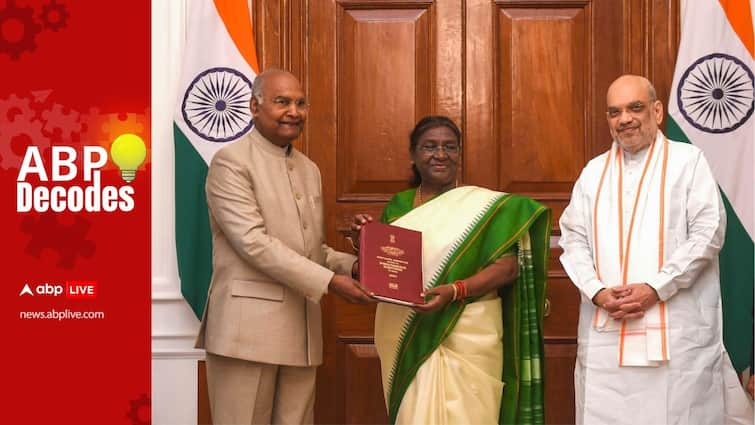‘One nation, one election’ could possibly be a actuality quickly because the centre on Wednesday gave nod to the suggestions made within the panel report headed by former president Ram Nath Kovind for holding simultaneous polls for the Lok Sabha, state assemblies and native our bodies.
Union Minister Ashwini Vaishnaw stated that an implementation group can be shaped to take ahead the suggestions and detailed discussions can be held on numerous fora throughout the nation over the following few months.
The initiative, that goals to synchronise Parliamentary and Meeting elections, has been part of the Prime Minister Narendra Modi-led NDA authorities’s 100-day agenda. Throughout the Independence Day tackle, PM Modi argued that frequent elections create impediments to the nation’s progress.
What Is The Kovind Committee Suggestion?
The 18,626-page report of Kovind panel committee is an end result of in depth consultations with stakeholders, specialists and analysis work of over six months because it was constituted in September final yr.
ALSO READ | ‘One Nation, One Election’ To Be A Reality Soon? Centre Decides To Table Bill In Parliament’s Winter Session
In March 2024, simply earlier than the Lok Sabha Election was introduced, the panel really helpful implementing ‘one nation, one election’ in two phases. The primary part would contain simultaneous polls for the Lok Sabha and state assemblies, whereas the second part would conduct elections for native our bodies inside 100 days of the overall election.
The panel additionally urged a standard electoral roll, which might require coordination between the Election Fee (ECI) and state election commissions. As of now, the EC oversees Lok Sabha and meeting polls, whereas state election commissions handle polls for municipalities and panchayats.
When Will One Nation, One Election Be Applied?
Although Ashwini Vaishnaw hasn’t elaborated on when would a laws be introduced on the reform, it’s possible that the federal government will introduce a invoice concerning ‘One nation, one election’ within the winter session of the Parliament. Vaishnaw, nevertheless, quoted Union Minister Amit Shah as saying that the federal government would implement it in its present tenure.
The federal government will attempt to construct a consensus over the following few months and solely after the method is finished after which the legislation ministry will draft a invoice and place it earlier than the cupboard and subsequently take it to the Parliament.
In accordance with the Ram Nath Kovind Committee report, when the Parliament meets, an appointed date needs to be determined to inform the transfer. As soon as the date is notified, all of the assemblies shaped within the state shall solely final until the interval as much as the Lok Sabha elections in 2029.
So, the simultaneous elections would start as soon as the date of the Lok Sabha elections is set in 2029. In these states, the place the time period of the meeting is past that date, their tenure shall be short-terminated to align with the overall elections.
How Will One nation, One Election Be Applied?
The implementation of the ‘One Nation One Ballot’ shall be completed by the implementation group which can take ahead the suggestions of the Kovind panel.
ALSO READ | Impractical, Gimmick, Compromises Democracy: Oppn Hits Out At Cabinet’s Nod To One Nation One Election
The group will execute the suggestions and the method shall be carried out in two phases: first for the Lok Sabha and meeting elections after which the second for native physique elections inside 100 days of basic elections, as talked about above.
Furthermore, there shall be a standard electoral roll for the three elections. The Voter ID playing cards shall be ready by the Election Fee in session with state election authorities, in accordance with News18.
Tracing The Thought Of ‘One Nation, One Election
A short timeline of India’s electoral historical past and the way the hole emerged between the Lok Sabha and Meeting polls:
– Simultaneous elections to the Lok Sabha and State Assemblies had been held in 1951-52, 1957, 1962 and 1967.
– Nonetheless, over time, the concurrent nature of elections was misplaced because the tenure of the Lok Sabha and state assemblies weren’t for a set size of time however a most length of 5 years.
– Between 1961 and 1970, 5 states — Bihar, Kerala, Punjab, Uttar Pradesh and West Bengal — had three elections.
– The situation additional deteriorated between 1971 and 1980 when 14 states witnessed elections thrice. In Odisha, polls had been carried out 4 instances on this decade.
– Between 1981 and 1990, 5 states had three elections. From 1991 to 2000, two states went via elections thrice and there have been 4 Lok Sabha polls.
– The thought of simultaneous elections got here up in 1983 when the Election Fee advocated the thought of conducting simultaneous elections for each the Lok Sabha and state legislative assemblies.
– Equally, in 2002, the Nationwide Fee to Assessment the Working of the Structure urged for the restoration of simultaneous polls.
– The Regulation Fee of India additionally really helpful simultaneous polls in its studies of 1999, 2015 and 2018.
– In January 2017, NITI Aayog formulated a working paper titled “Evaluation of Simultaneous Elections: The What, Why and How”, exploring the prospect of holding concurrent elections for the Lok Sabha and state legislative assemblies.
– In 2019, an all-party assembly was held in Delhi and it was attended by 19 political events to debate important reforms in governance, together with simultaneous elections.
dwelling

